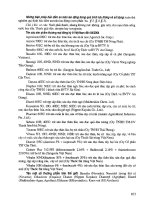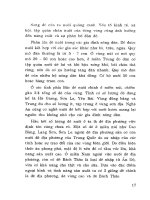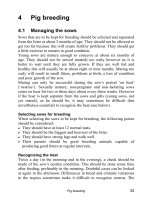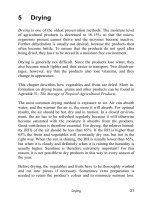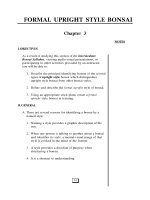INTERMEDIATE BONSAI - Part 3 pot
Bạn đang xem bản rút gọn của tài liệu. Xem và tải ngay bản đầy đủ của tài liệu tại đây (133.54 KB, 14 trang )
SEMI-CASCADE STYLE BONSAI
Chapter 7
NOTES
I. OBJECTIVES
As a result of studying this section of the Intermediate
Bonsai Syllabus, viewing audio visual presentations, or
participating in other activities provided by an instructor,
you will be able to:
1. Describe the principal identifying features of semi-
cascade style bonsai which distinguish it from other
bonsai styles.
2. Using an appropriate stock plant, create a semi-cascade
style bonsai in training.
II. GENERAL
A. A cascade style bonsai is one in which a major feature
extends below the lower rim of the pot.
B. A semi-cascade style bonsai is one in which the major
cascading feature extends below the top rim of the pot but
does not extend below the bottom of the pot.
C. The semi-cascade style bonsai may incorporate one or
more of the characteristics of an informal upright, a
slanting and a cascade style tree.
D. It depicts a tree in nature growing on a mountain top with
all or a part of it hanging over the edge.
7-1
Semi-Cascade Style Bonsai, Continued
NOTES
III. SEMI-CASCADE STYLE BONSAI DEFINED
Illus 7-1
A. The semi-cascade style bonsai is one in
which there is an informal upright or
slanting style trunk whose trunk, or
unusually long first branch, cascades
below the rim of the pot but not below
the base of the pot.
B. Trunk
1. May be in the informal upright style
with a semi-cascading branch.
2. May be extremely slanted, extending to the right or to
the left over the edge of the container and then
cascades below the top rim of the container but not
below the bottom of the pot.
3. Tapered from a wide base to a narrow apex.
C. Branches
1. On the trunk in the informal upright style semi-
cascade bonsai, the first branch is usually long and
cascades below the rim of the pot but not below the
base of the pot. The remainder of the branches are as
on an informal upright style bonsai.
2. On the extremely slanted style the first branch is often
a rear branch and the remainder of the branches
project to the front and to the rear.
D. Container
1. The container should be relatively deep and may be
round, square, octagonal, hexagonal, or a deep cascade.
2. The container may be glazed or unglazed depending
on the species of tree.
7-2
Semi-Cascade Style Bonsai, Continued
NOTES
IV. STYLING THE TREE
A. Roots
1. Remove surface soil down to relatively thick radiating
Direction of lean
Illus 7-2
roots.
2. Surface roots should radiate in several directions but
should be strongest on the side away from the
direction of the lean.
B.
Illus 7-3
Trunk
1. On an informal upright style
bonsai with a semi-cascading
branch:
a. The curved trunk should
emerge from the soil at an
angle.
b. The front of the tree must
have either the semi-
cascading branch to the
right or to the left. Which of
the two sides is selected as
the front depends on the
trunk’s other characteristics
and branching.
c. The radius of the trunk’s curves should become
less higher up on the trunk.
7-3
Semi-Cascade Style Bonsai, Continued
NOTES
2. On an the extremely slanted semi-cascade style tree:
a. The curved trunk should emerge from the soil at
an extreme angle toward the side of the container
over which it cascades.
b. In the vicinity of the lip of the container, the trunk
arcs downward, below the lip of the container, and
then turns parallel to the table or bench on which it
is placed.
Illus 7-4
C. Branches
1. On an informal upright with a semi-cascading branch:
a. The semi-cascading branch should be the lowest
and heaviest branch. It should extend at about a 45
degree angle to approximately midway between the
rim and base of the pot. The tip should flare
upward.
b. The remainder of the branches are positioned and
styled as on an informal upright style bonsai.
2. On the extremely slanted tree:
a. The first branch should be a rear branch to give an
7-4
Semi-Cascade Style Bonsai, Continued
NOTES
immediate sense of depth.
b. Shorter branches may project toward the front.
c. An upright apex may be created toward the tip of
the cascade using a vertical growing branch. It is
then styled as a small informal upright tree.
V. POTTING THE TREE
A. Prepare the correct size and style container as described
earlier, and assemble the appropriate soil mix.
B. Decide on the tree’s location in the pot.
1. Position it in the container to the rear of the center
line and either left or right of the center.
a. In deciding whether to place it to the left or to the
right consider the location of the cascading
element.
b. If the cascading element is on the right, position the
tree to the left of center. Vice versa if the cascading
element if on the left.
C. Remove soil and roots from the rear and from the left or
right side depending on placement.
Note: Details on potting are discussed in the chapter on formal
upright style bonsai and will not be repeated here.
VI. SUMMARY
A. A semi-cascade style bonsai is one in which there is either
an informal upright or slanting style trunk whose trunk,
or unusually long first branch, cascades below the rim of
the pot but not below the base of the pot.
B. It has a curved trunk, tapered from base to apex.
7-5
Semi-Cascade Style Bonsai, Continued
NOTES
C. The container is relatively deep and may be circular,
square or a deep cascade and may be glazed or unglazed
depending on species of tree
D. The tree is positioned in its container to the rear of the
center line and either left or right of the center depending
upon the location of the lowest branch or other
characteristics which provide weight and mass.
7-6
CASCADE STYLE BONSAI
Chapter 8
NOTES
I. OBJECTIVES
As a result of studying this section of the Intermediate
Bonsai Syllabus, viewing audio visual presentations, or
participating in other activities provided by an instructor,
you will be able to:
1. Describe the principal identifying features of cascade
style bonsai which distinguish it from other bonsai
styles.
2. Explain the difference between a formal and an
informal cascade bonsai.
3. Using an appropriate stock plant, create a cascade style
bonsai in training.
II. GENERAL
A. A cascade bonsai is one in which the trunk begins
Illus 8-1
growing upward but abruptly turns downward and
cascades to a point below the bottom of the container.
B. Bonsai created in the cascade style resemble trees
growing on steep slopes in mountainous areas, in
ravines, or along drainage ditches.
1. As the tree grows, matures and gets heavier, gravity
may have pulled it over, leaving its roots intact.
2. The weight and volume of grape vines or other
climbing vines may cause the tree to tip over.
3. Soil around the roots may erode and the tree tips over
and down a slope.
8-1
Cascade Style Bonsai, Continued
NOTES
4. A snow, ice, mud or rock slide may knock the tree
over, but its roots cling to the slope.
III. FORMAL CASCADE STYLE BONSAI DEFINED
A. The tree has one or more cascading
trunk lines as well as
Illus 8-2
a branch which
has been trained as an small upright
tree. The top of the tree, the base of the
trunk, the bottom center of the
container and the tip of the cascade are
in line as viewed from the front.
B. Trunk and Branches
1. The small upright tree forming the
apex should grow from the top of
the arch of the cascading trunk,
preferably from the highest point of
the arch.
a. The trunk of the small upright
tree forming the apex should be
curved to complement the
curves of the cascade.
b. The apex of this small upright tree should be over
the cascade’s center trunk/pot line.
c. Its primary branches should be positioned and
trained as on an informal upright tree.
2. The initial angle of descent is about 45 degrees.
3. Further down the cascade the angle of descent may be
as much as 90 degrees.
4. The tip of the cascade flares upward in search of the
light.
8-2
Cascade Style Bonsai, Continued
NOTES
5. The front of a cascade is located about 45 degrees to the
Front
Illus 8-3
left or to the right of the trunk where it passes over the
lip of the container.
6. The arch of the cascade crosses the lip of the container
at or near a corner and/or over a foot of the container.
C. The container should be deeper than it is long or wide.
IV. INFORMAL or VERTICAL CASCADE STYLE
BONSAI DEFINED
A. The tree has one or more cascading trunk lines with no
Illus 8-4
upward growth.
B. Trunk
1. The base of the trunk, the bottom center of the
container and the tip of the cascade are in line as
viewed from the front.
2. The initial angle of descent is 45 to
90 degrees.
3. The angle of descent may change
in the lower section of the cascade
to achieve a proper balance point.
4. The tip of the cascade flares
upward.
5. The front of a cascade is located
about 45 degrees to the left or to
the right of the trunk where it
passes over the lip of the
container.
6. The arch of the cascade crosses the lip of the container
at or near a corner and/or over a foot of the container.
C. The container should be deeper than it is long or wide.
8-3
Cascade Style Bonsai, Continued
NOTES
V. STYLING THE TREE
A. Selecting material
1. Select a species which will tolerate growing
downward; one which grows prostrate (reclining,
trailing and earth hugging) naturally such as a juniper
procumbens nana.
2. The specimen selected should have a strong branch or
trunk which can be grown in a prostrate attitude.
a. The trunk/branch should have a sharp bend a
short distance above the roots, or be flexible
enough that a sharp bend can be created.
b. The branch/trunk should have interesting curves.
c. The branch/trunk should have adequate secondary
branches which can be trained as side branches.
B. Determine the tree’s front by observing root structure and
the main trunk line. The first left or right curve should be
towards the viewer with the trunk line positioned about
45 degrees to the left or to the right as viewed from the
front of the container.
C. If the bonsai is to be a formal style, select a branch near the
top of the arch of the main trunk. This will be trained as
the new upright-growing apex.
D. Wire and bend the main trunk to the desired position.
1. The first bend on the main trunk below the arch
should be towards the center of the composition.
2. The initial angle of descent is between 45 degrees and
90 degrees depending on the style. However, the trunk
will slightly serpentine in towards the container and
out away from the container.
8-4
Cascade Style Bonsai, Continued
NOTES
3. The trunk should serpentine to the left and to the
right as it descends.
4. The last curve in the trunk should be towards the
viewer and towards the center of the container.
5. Multiple trunk cascades will have proportions similar
to those of a multiple trunk upright bonsai:
a. Vary in girth; the shorter being of smaller girth.
b. Vary in length, the shorter being either 1/3 the
length of the longer cascade, or 2/3 the length of
the longer cascade. (Never 1/2 the length.)
c. The junction of the shorter cascade with the longer
cascade should be relatively high in the
composition.
E. Placement of primary branches.
1. Primary branches should alternate to the right and to
the left of the trunk. Additionally, they should grow
from the outside of the curves on the trunk.
2. There will seldom be any branches growing towards
the rear of the composition. However an
occasional short branch may be grown
towards the front.
3. Primary and secondary branches will be
wired so that they are parallel to the
table/floor.
Illus 8-5
4. Several branches which are not being kept
as live branches may be stripped and
displayed as dead wood.
8-5
Cascade Style Bonsai, Continued
NOTES
VI. POTTING THE TREE
A. Container selection
1. Cascade bonsai use deep containers. The depth
depends on the size and style of the bonsai.
a. The container depth should be more than or less
than, but not equal to, the length of the cascade.
b. Additionally, if there is an upright tree above the
cascade, the container depth should be more than
or less than, but not equal to, the height of that
upright tree.
c. The container for a cascade may look best if it is
shorter than the length of the cascading branch or
shorter than the height of the tree when the tree is
rugged looking with a heavy trunk. A short stocky
tree looks best in a short stocky container.
d. A more graceful, younger or sparsely foliaged
cascade looks best in a taller container.
2. The diameter of the cascade container should be
figured by totalling the following measurements:
a. The space which the anchor root takes up on the
back side of the tree,
b. Plus the trunk diameter,
c. Plus the distance between the trunk and the
cascading branch.
d. These three measurements equal the approximate
diameter of the pot.
8-6
Cascade Style Bonsai, Continued
NOTES
B. Potting
1. Position the base of the tree in the center of
or slightly forward in the container.
2. Position the apex in formal cascades to align
with the center line of the container.
Illus 8-6
Illus 8-7
3. Position the tip of the arch in vertical cascades to align
with the center line of the container.
4. The trunk should not touch the rim of the container.
5. Position the main descending trunk over the
corner/foot of the container. The trunk does not come
down the front/center of the container because:
a. It would conceal the trunk’s base and rootage.
b. The attractive first curve would not be shown to
advantage.
8-7
Cascade Style Bonsai, Continued
NOTES
c. The surface of the container would be concealed.
d. It would be too symmetrical.
6. Complete the potting process.
C. Maintenance. If the lower end of the cascade appears to be
weak:
1. Each day after watering lay the tree and its pot on its
side with the cascading branch facing up and
horizontal.
2. When fertilizing, foliar feed the lower end of the
cascade.
VII. DISPLAYING CASCADE STYLE BONSAI
A. Display on a tall, slender stand to complement the tree
and the container’s vertical line.
B. Use a light and open stand to maximize the hanging
effect.
C. The height of the stand either should be shorter or taller
than the height of the container, but not equal to the
height of the container.
VIII. SUMMARY
A. Various forces in nature can create a cascade style tree.
B. A bonsai styled as a cascade may be a formal cascade with
a branch trained as a small upright tree at the apex, or as
an informal cascade bonsai with a bare apex.
C. Cascade bonsai are planted in a container which is deeper
than it is wide.
8-8
